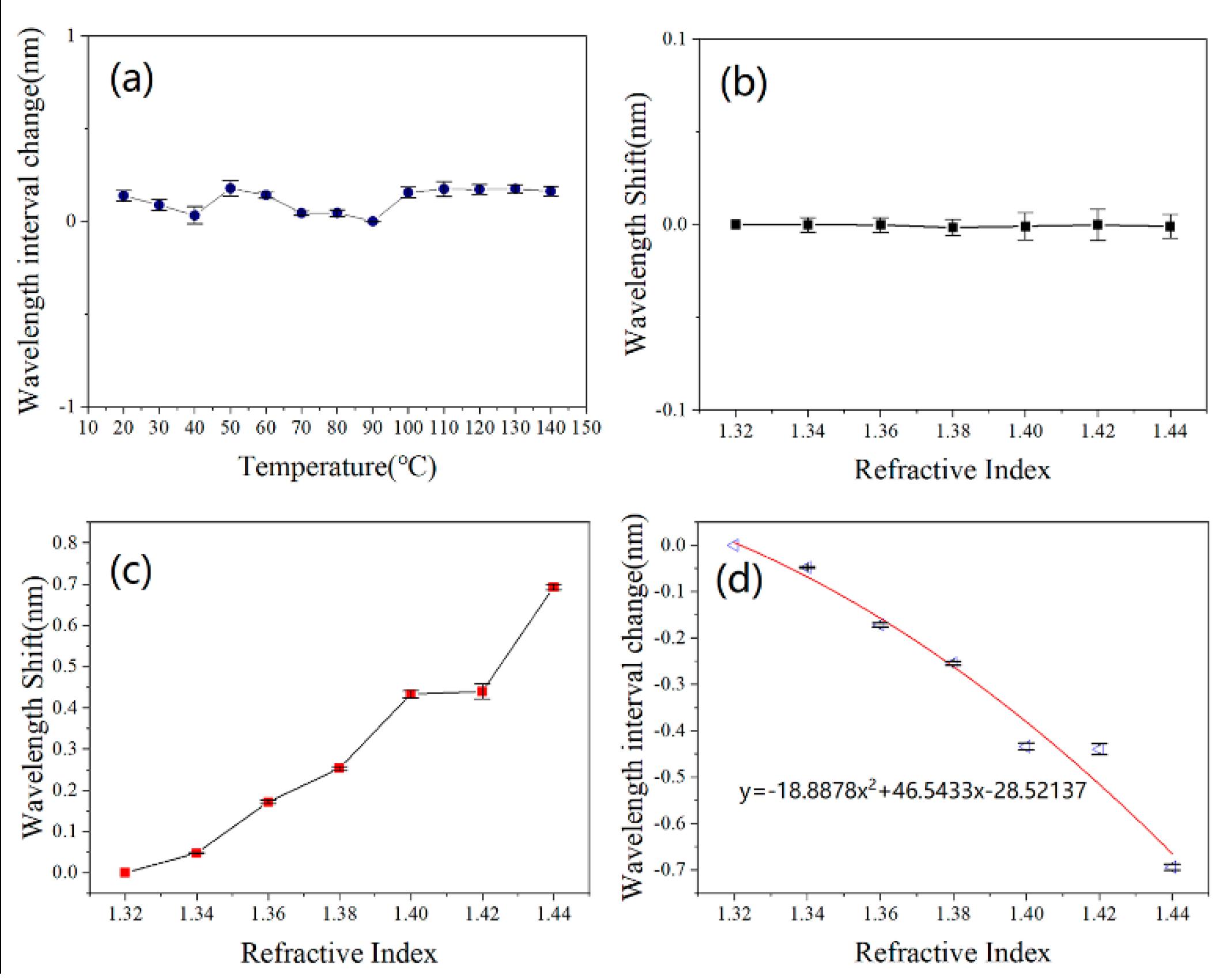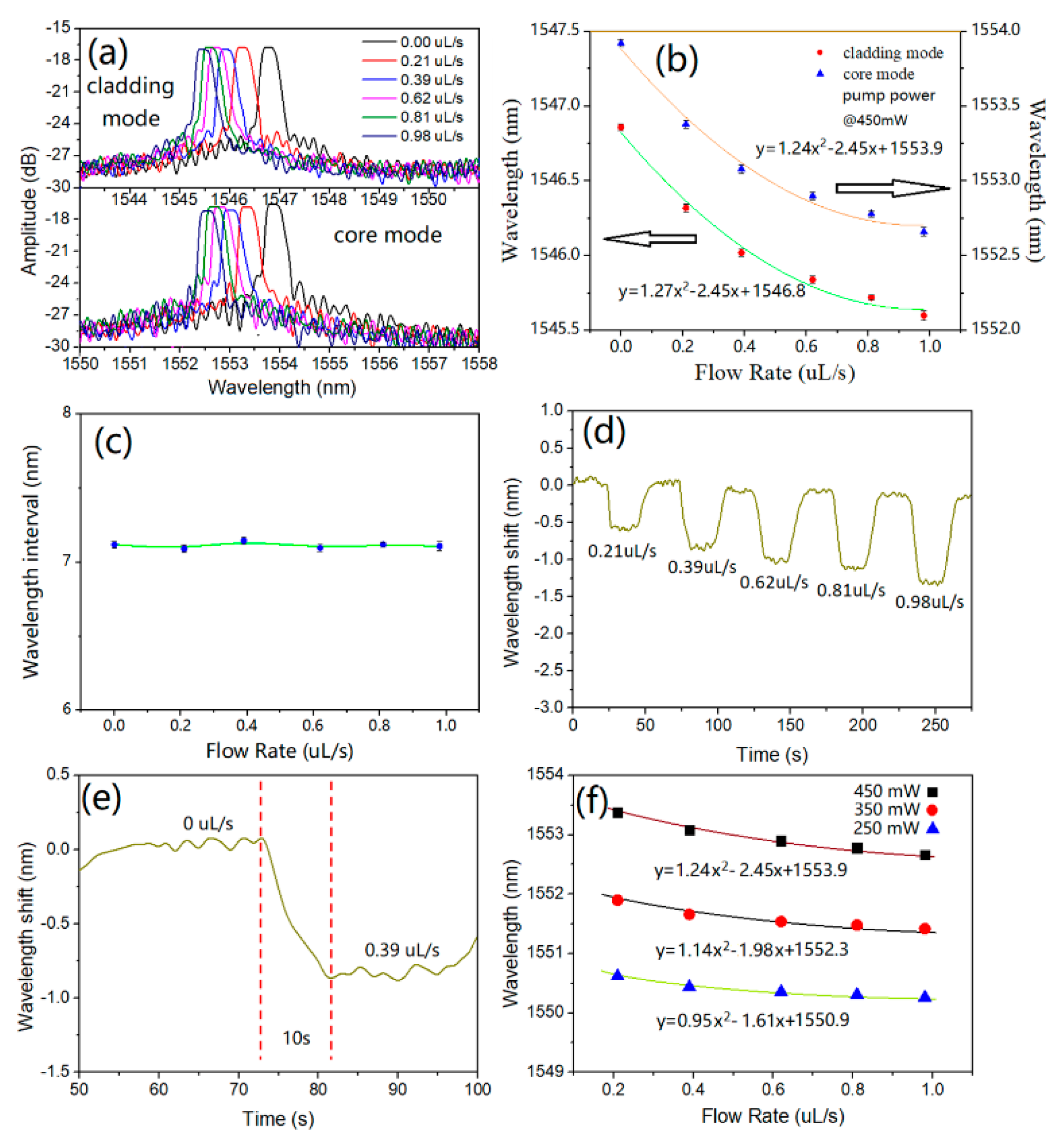Simultaneous Measurement of Refractive Index and Flow Rate Using a Co2+-Doped Microfiber
Abstract
:1. Introduction
2. Materials and Methods
2.1. Fabrication of the Co-MFBGS
2.2. Principle of the Proposed Sensor
2.3. Experimental Setup
3. Results
4. Conclusions
Author Contributions
Funding
Institutional Review Board Statement
Informed Consent Statement
Data Availability Statement
Conflicts of Interest
References
- Fang, X.; Liao, C.R.; Wang, D.N. Femtosecond laser fabricated fiber Bragg grating in microfiber for refractive index sensing. Opt. Lett. 2010, 35, 1007–1009. [Google Scholar] [CrossRef] [PubMed] [Green Version]
- Liao, C.; Yang, K.; Wang, J.; Bai, Z.; Gan, Z.; Wang, Y. Helical Microfiber Bragg Grating Printed by Femtosecond Laser for Refractive Index Sensing. IEEE Photonics Technol. Lett. 2019, 31, 971–974. [Google Scholar] [CrossRef]
- Sumetsky, M.; Dulashko, Y.; Hale, A. Fabrication and study of bent and coiled free silica nanowires: Self-coupling microloop optical interferometer. Opt. Express 2004, 12, 3521–3531. [Google Scholar] [CrossRef]
- Kakarantzas, G.; Dimmick, T.E.; Birks, T.A.; Le Roux, R.; Russell, P.S.J. Miniature all-fiber devices based on CO(2) laser microstructuring of tapered fibers. Opt. Lett. 2001, 26, 1137–1139. [Google Scholar] [CrossRef]
- Zhang, E.J.; Sacher, W.D.; Poon, J.K.S. Hydrofluoric acid flow etching of low-loss subwavelength-diameter biconical fiber tapers. Opt. Express 2010, 18, 22593–22598. [Google Scholar] [CrossRef] [PubMed]
- Iadicicco, A.; Cusano, A.; Cutolo, A.; Bernini, R.; Giordano, M. Thinned Fiber Bragg Gratings as High Sensitivity Refractive Index Sensor. IEEE Photonics Technol. Lett. 2004, 16, 1149–1151. [Google Scholar] [CrossRef]
- Liang, W.; Huang, Y.; Xu, Y.; Lee, R.K.; Yariv, A. Highly sensitive fiber Bragg grating refractive index sensors. Appl. Phys. Lett. 2005, 86, 151122. [Google Scholar] [CrossRef]
- Bekmurzayeva, A.; Dukenbayev, K.; Shaimerdenova, M.; Bekniyazov, I.; Ayupova, T.; Sypabekova, M.; Molardi, C.; Tosi, D. Etched Fiber Bragg Grating Biosensor Functionalized with Aptamers for Detection of Thrombin. Sensors 2018, 18, 4298. [Google Scholar] [CrossRef] [Green Version]
- Liu, T.; Liang, L.-L.; Xiao, P.; Sun, L.-P.; Huang, Y.-Y.; Ran, Y.; Jin, L.; Guan, B.-O. A label-free cardiac biomarker immunosensor based on phase-shifted microfiber Bragg grating. Biosens. Bioelectron. 2018, 100, 155–160. [Google Scholar] [CrossRef]
- Ahsani, V.; Ahmed, F.; Jun, M.; Bradley, C. Tapered Fiber-Optic Mach-Zehnder Interferometer for Ultra-High Sensitivity Measurement of Refractive Index. Sensors 2019, 19, 1652. [Google Scholar] [CrossRef] [Green Version]
- Yan, S.-C.; Xu, F. A review on optical microfibers in fluidic applications. J. Micromech. Microeng. 2017, 27, 093001. [Google Scholar] [CrossRef]
- Zhang, Q.; Hu, L.; Qi, Y.; Liu, G.; Ianno, N.; Han, M. Fiber-optic refractometer based on a phase-shifted fiber Bragg grating on a side-hole fiber. Opt. Express 2015, 23, 16750–16759. [Google Scholar] [CrossRef]
- Miao, Y.; He, Y.; Ma, X.; Zhang, H.; Song, B.; Yang, X.; Xue, L.; Liu, B.; Yao, J. Low-Temperature Cross-Sensitivity Refractive Index Sensor Based on Single-Mode Fiber With Periodically Modulated Taper. IEEE Sens. J. 2016, 16, 2442–2446. [Google Scholar] [CrossRef]
- Ribaut, C.; Loyez, M.; Larrieu, J.-C.; Chevineau, S.; Lambert, P.; Remmelink, M.; Wattiez, R.; Caucheteur, C. Cancer biomarker sensing using packaged plasmonic optical fiber gratings: Towards in vivo diagnosis. Biosens. Bioelectron. 2017, 92, 449–456. [Google Scholar] [CrossRef] [PubMed]
- Esposito, F.; Sansone, L.; Taddei, C.; Campopiano, S.; Giordano, M.; Iadicicco, A. Ultrasensitive biosensor based on long period grating coated with polycarbonate-graphene oxide multilayer. Sens. Actuators B Chem. 2018, 274, 517–526. [Google Scholar] [CrossRef]
- Li, K.; Liu, G.; Wu, Y.; Hao, P.; Zhou, W.; Zhang, Z. Gold nanoparticle amplified optical microfiber evanescent wave absorption biosensor for cancer biomarker detection in serum. Talanta 2014, 120, 419–424. [Google Scholar] [CrossRef]
- Jaddoa, M.F.; Jasim, A.A.; Ab Razak, M.Z.; Harun, S.; Ahmad, H. Highly responsive NaCl detector based on inline microfiber Mach–Zehnder interferometer. Sens. Actuators A Phys. 2016, 237, 56–61. [Google Scholar] [CrossRef]
- Luo, H.; Sun, Q.; Xu, Z.; Liu, D.; Zhang, L. Simultaneous measurement of refractive index and temperature using multimode microfiber-based dual Mach-Zehnder interferometer. Opt. Lett. 2014, 39, 4049–4052. [Google Scholar] [CrossRef]
- Zhang, Y.; Lin, B.; Tjin, S.C.; Zhang, H.; Wang, G.; Shum, P.; Zhang, X. Refractive index sensing based on higher order mode reflection of a microfiber Bragg grating. Opt. Express 2010, 18, 26345–26350. [Google Scholar] [CrossRef]
- Gao, R.; Ye, J.; Xin, X. An Integrated Biological Analysis and Flow Rate Sensing for the Real-Time Detection of Carcinogen in Water Based on Co2+-Doped Optical Fibers. IEEE Sens. J. 2019, 20, 1912–1921. [Google Scholar] [CrossRef]
- Gong, Y.; Liu, Q.-F.; Zhang, C.-L.; Wu, Y.; Rao, Y.-J.; Peng, G.-D. Microfluidic Flow Rate Detection with a Large Dynamic Range by Optical Manipulation. IEEE Photonics Technol. Lett. 2015, 27, 2508–2511. [Google Scholar] [CrossRef]
- Garza-García, L.D.; García-López, E.; Camacho-León, S.; Rocha-Pizaña, M.D.R.; López-Pacheco, F.; López-Meza, J.; Araiz-Hernández, D.; Tapia-Mejía, E.J.; Santiago, G.T.-D.; Rodríguez-González, C.A.; et al. Continuous flow micro-bioreactors for the production of biopharmaceuticals: The effect of geometry, surface texture, and flow rate. Lab Chip 2014, 14, 1320–1329. [Google Scholar] [CrossRef]
- Gong, Y.; Zhang, M.; Gong, C.; Wu, Y.; Rao, Y.; Fan, X. Sensitive optofluidic flow rate sensor based on laser heating and microring resonator. Microfluid. Nanofluidics 2015, 19, 1497–1505. [Google Scholar] [CrossRef]
- Li, Y.; Yan, G.; Zhang, L.; He, S. Microfluidic flowmeter based on micro “hot-wire” sandwiched Fabry-Perot interferometer. Opt. Express 2015, 23, 9483–9493. [Google Scholar] [CrossRef] [PubMed]
- Yan, S.C.; Liu, Z.Y.; Li, C.; Ge, S.J.; Xu, F.; Lu, Y.Q. “Hot-wire” microfluidic flowmeter based on a microfiber coupler. Opt. Lett. 2016, 41, 5680–5683. [Google Scholar] [CrossRef]
- Kou, J.-L.; Ding, M.; Feng, J.; Lu, Y.-Q.; Xu, F.; Brambilla, G. Microfiber-Based Bragg Gratings for Sensing Applications: A Review. Sensors 2012, 12, 8861–8876. [Google Scholar] [CrossRef]
- Kersey, A.D.; Davis, M.A.; Patrick, H.J.; LeBlanc, M.; Koo, K.P.; Askins, C.G.; Putnam, M.A.; Friebele, E.J. Fiber Grating Sensors. J. Lightwave Technol. 1997, 15, 1442–1463. [Google Scholar] [CrossRef] [Green Version]
- Liu, Z.; Tse, M.-L.V.; Zhang, A.P.; Tam, H.-Y. Integrated microfluidic flowmeter based on a micro-FBG inscribed in Co²?-doped optical fiber. Opt. Lett. 2014, 39, 5877–5880. [Google Scholar] [CrossRef] [PubMed]
- Bruun, H.H. Hot-Wire Anemometry: Principles and Signal Analysis. Meas. Sci. Technol. 1996, 7. [Google Scholar] [CrossRef] [Green Version]




Publisher’s Note: MDPI stays neutral with regard to jurisdictional claims in published maps and institutional affiliations. |
© 2021 by the authors. Licensee MDPI, Basel, Switzerland. This article is an open access article distributed under the terms and conditions of the Creative Commons Attribution (CC BY) license (https://creativecommons.org/licenses/by/4.0/).
Share and Cite
Liu, D.; Gao, R.; Li, Z.; Qi, A. Simultaneous Measurement of Refractive Index and Flow Rate Using a Co2+-Doped Microfiber. Appl. Sci. 2021, 11, 10525. https://doi.org/10.3390/app112210525
Liu D, Gao R, Li Z, Qi A. Simultaneous Measurement of Refractive Index and Flow Rate Using a Co2+-Doped Microfiber. Applied Sciences. 2021; 11(22):10525. https://doi.org/10.3390/app112210525
Chicago/Turabian StyleLiu, Da, Ran Gao, Zhipei Li, and Anle Qi. 2021. "Simultaneous Measurement of Refractive Index and Flow Rate Using a Co2+-Doped Microfiber" Applied Sciences 11, no. 22: 10525. https://doi.org/10.3390/app112210525
APA StyleLiu, D., Gao, R., Li, Z., & Qi, A. (2021). Simultaneous Measurement of Refractive Index and Flow Rate Using a Co2+-Doped Microfiber. Applied Sciences, 11(22), 10525. https://doi.org/10.3390/app112210525





